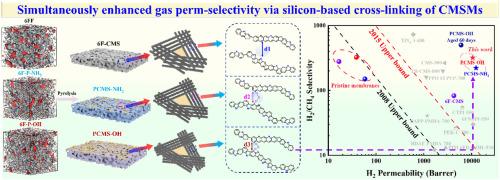Simultaneously enhanced gas perm-selectivity of carbon molecular sieve membranes via silicon-based molecular cross-linking for efficient gas separation
IF 9
1区 工程技术
Q1 ENGINEERING, CHEMICAL
引用次数: 0
Abstract
Carbon molecular sieve membranes (CMSMs) face a fundamental permeability-selectivity trade-off, as defined by the Robeson upper bound. Here, we engineer CMSMs via copolymerization of hydroxy-functionalized polyimide (6FDA-6FAP) with polydimethylsiloxane (PDMS). Incorporating flexible siloxane chains promotes denser chain aggregation and provides additional gas transport channels. During pyrolysis, the decomposition of siloxane segments generates additional micropores, thereby enhancing gas permeability. Simultaneously, PDMS-induced silicon inter-layer crosslinking promotes tighter packing of carbon strands, which reduces inter-layer spacing and consequently improves gas selectivity. Systematic comparison of hydroxyl (-OH) and amine (-NH2) functional groups reveals that –OH groups in PDMS form extensive hydrogen-bonding networks with 6FAP, inducing crosslinking that enhances precursor chain packing. The optimized PCMS-OH membrane achieves H2 and CO2 permeability of 10,568 and 1,768 Barrer, with H2/CH4 and CO2/CH4 selectivity of 320 and 53, respectively, which far exceed the latest Robeson upper bound. Moreover, silicon-induced crosslinking reduces aging kinetics, retaining 57 % higher H2 permeability after 60 days. This work demonstrates a precursor engineering strategy to break the trade-off barrier for sustainable hydrogen purification and carbon dioxide capture.

同时通过硅基分子交联提高碳分子筛膜的气体选择性,实现高效的气体分离
碳分子筛膜(cmms)面临着一个基本的渗透性和选择性权衡,由罗布森上界定义。在这里,我们通过羟基功能化聚酰亚胺(6FDA-6FAP)与聚二甲基硅氧烷(PDMS)的共聚来设计cmms。结合柔性硅氧烷链促进更密集的链聚集,并提供额外的气体输送通道。在热解过程中,硅氧烷段的分解产生了额外的微孔,从而提高了气体的渗透性。同时,pdms诱导的硅层间交联促进了碳链的紧密堆积,减少了层间间距,从而提高了气体选择性。对羟基(-OH)和胺(-NH2)官能团的系统比较表明,PDMS中的-OH官能团与6FAP形成广泛的氢键网络,诱导交联,增强前体链包装。优化后的PCMS-OH膜H2和CO2的渗透率分别为10,568 Barrer和1,768 Barrer, H2/CH4和CO2/CH4的选择性分别为320和53,远远超过最新的Robeson上限。此外,硅诱导的交联降低了老化动力学,在60天后保持了57%的H2渗透率。这项工作展示了一种前体工程策略,以打破可持续氢净化和二氧化碳捕获的权衡障碍。
本文章由计算机程序翻译,如有差异,请以英文原文为准。
求助全文
约1分钟内获得全文
求助全文
来源期刊

Journal of Membrane Science
工程技术-高分子科学
CiteScore
17.10
自引率
17.90%
发文量
1031
审稿时长
2.5 months
期刊介绍:
The Journal of Membrane Science is a publication that focuses on membrane systems and is aimed at academic and industrial chemists, chemical engineers, materials scientists, and membranologists. It publishes original research and reviews on various aspects of membrane transport, membrane formation/structure, fouling, module/process design, and processes/applications. The journal primarily focuses on the structure, function, and performance of non-biological membranes but also includes papers that relate to biological membranes. The Journal of Membrane Science publishes Full Text Papers, State-of-the-Art Reviews, Letters to the Editor, and Perspectives.
 求助内容:
求助内容: 应助结果提醒方式:
应助结果提醒方式:


